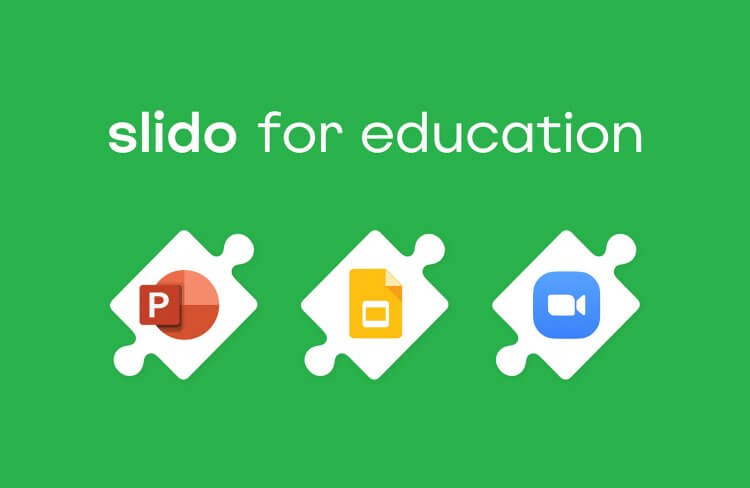There’s no reason to risk missing over half of your team’s contributions. Because that’s how much you can lose in the shuffle if your introverted colleagues feel left out. Learn how Slido can help you host introvert-friendly meetings in 4 steps.
We’ll cover:
- Introverts in workplaces face unconscious bias
- 4 steps to help introverts stand out in the team
- Anonymous contributions from introverts
- Structure your meetings with introverts in mind
- Plan ahead: Ask the team what sparks their interest
Introverts in workplaces face unconscious bias
Quiet, timid, immersed in their own workflow, introverts are commonly not vocal about their passions and aspirations. They just tend to express their enthusiasm differently, often falling victim to unconscious bias.
According to a recent HBR study, unconscious bias makes introverts less likely to get a raise or promotion compared to their more outwardly extroverted counterparts. But this neglect doesn’t hurt only introverts.
In her recent findings, Dr. Jennifer Kahnweiler revealed that companies risk losing 40 to 60% of their team’s contributions if they fail to build an introvert-friendly work environment.
4 steps to help introverts shine in the team
To tap into the full potential of your team, it’s vital to make space for introverts to stand out. All it takes is four simple steps: allow anonymity, create space for thinking, plan your meetings well and communicate in advance. Let’s dig into each of these in more detail.
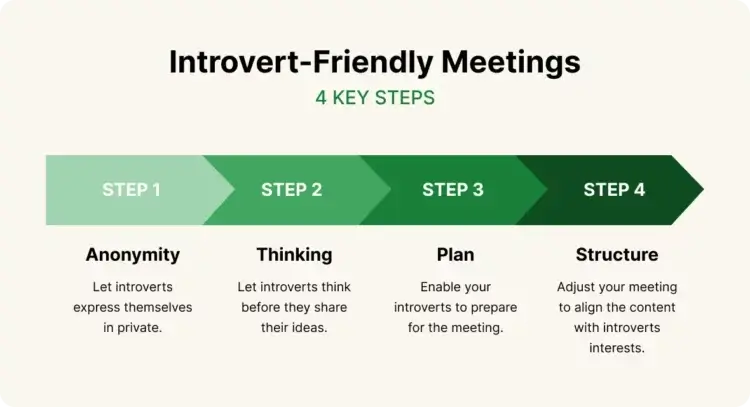
#1 Anonymous contributions from introverts
A recent study from The Kellogg School found that in six to eight person meetings, three people do 70% of the talking.
When a small vocal group dominates the discussion in team meetings, it’s harder to get input from the quieter members. This results in a loss of diverse perspectives which can impact the overall quality of output from your team.
Even more troubling, the study also shows that this disparity not only puts introverts’ ideas to waste, it severely disrupts their connection with the team and impacts their confidence.
One thing that can help create space for introverts and extroverts alike to voice what’s on their mind, is to embrace anonymous inputs.
Anonymity can remove the fear of judgement which can boost confidence. As a team lead, if you compliment good contributions, you can increase your team’s confidence which will make them more likely to speak up or use their name next time.
Anonymity can be particularly helpful for quieter or introverted participants when you are brainstorming ideas, collecting input or asking for feedback.
Slido lets you collect your team’s input and run polls anonymously, fostering psychological safety, and encouraging innovative thinking.
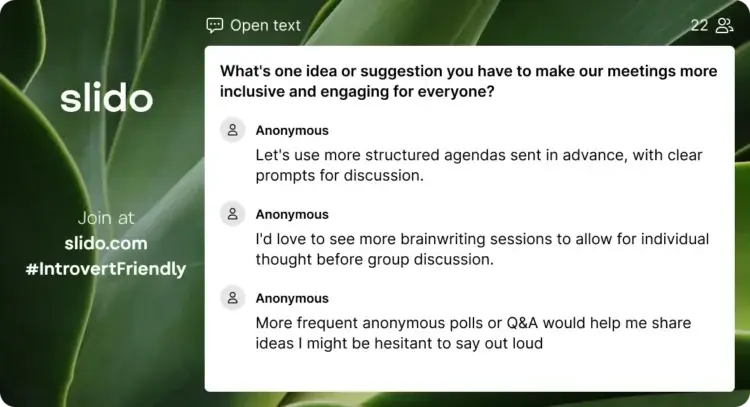
How to go anonymous with Slido
Anonymous polling through Slido is a suitable tool for creating a more balanced environment in meetings and empowering all voices. Here’s a quick guide on how to set up anonymous polls in Slido.
- Choosing the right privacy option for your polls: Slido offers four privacy options for participants. To enable anonymous contributions and ensure full privacy, select the setting that best meets your team’s needs. For team brainstorming or feedback sessions, select either Anonymous by Default or Always Stay Anonymous option to encourage free input without the influence of bias.
- Collecting anonymous input: With anonymity enabled, launch your poll or Q&A session. Participants can submit responses and ideas freely, without their names attached. This helps foster a psychologically safe environment where everyone feels comfortable sharing their unique perspectives.
- Engaging with the results: Once responses are collected, review and discuss the results as a group, focusing on the ideas rather than who submitted them. This approach not only boosts inclusivity but also increases the likelihood of capturing unique, creative solutions from team members who may not typically speak up.
💡 Learn more about Slido’s anonymity settings.
#2 Brainwriting instead of brainstorming
Brainstorming is a great way to free your team’s creativity. However, it can fall short of engaging the whole team, since larger groups and having to come up with ideas on the spot can put introverts outside their comfort zone.
To overcome this challenge, consider setting up a clear prompt and create space to let the team write their ideas down before sharing them. This technique is called brainwriting and is particularly effective in fueling creative thinking across the entire group, not just the most vocal individuals.

According to business psychology professor Tomas Chamorro-Premuzic, individuals are more likely to generate a higher volume of creative, original ideas, when not interacting with others. Conversely, traditional brainstorming increases the likelihood to harm and bottleneck creativity in larger teams.
Firstly, each team member has to wait their turn to speak, interrupting their flow of thought and potentially causing them to lose valuable ideas. Especially for introverts, the pressure of speaking up in a group can create anxiety and hinder creativity.
Secondly, less outspoken individuals may contribute less, assuming others will carry the weight of idea generation.
Finally, a few vocal individuals tend to dominate the conversation, preventing others from sharing their contributions. This combination of factors leads to inefficient use of time and a limited range of idea-making, ultimately hindering the team’s overall productivity.
Brainwriting, on the other hand, can serve as a great vessel to unleash ideas, without the limitations of classical brainstorming.
💡Useful tip: While brainwriting is an introvert-friendly technique, they are not the only ones who can greatly benefit from adopting this practice. Having time to write ideas down also helps colleagues with social anxiety and those who speak different languages and levels the playing field between remote and onsite team members.
How to create engaging brainwriting sessions in your team?
It takes only 3 simple steps to fully embrace brainwriting in your teams. Generate ideas, run a feedback round and then refine the best ideas together. Before jumping onto it, don’t forget to share clear instructions with the team.
- Individual idea generation: Invite each participant to write down their ideas within a set timeframe. This can be done synchronously (all at once) or asynchronously (in their own time). Ideas should be recorded in a structured way, either in individual documents that can later be shared or directly in a shared document, allowing everyone to work independently without influence from others. This step encourages unique, original contributions.
- Initial feedback round: Once all ideas are consolidated into a single document, initiate a feedback round. Encourage participants to review each other’s ideas, adding constructive questions, comments or suggestions. This round can also be conducted synchronously or asynchronously to allow time for thoughtful feedback. This collaborative review builds the foundation for idea expansion and refinement.
- Group discussion and refinement: Bring the group together, either in person or virtually, for a discussion session. In this meeting, participants can collectively explore, prioritize and refine ideas, combining perspectives to identify the most promising concepts. Ensure the discussion remains open, supportive and solution-focused to foster a sense of ownership and motivation within the team.
How can Slido help? You can run a live open text poll and let your teammates submit their favorite ideas.
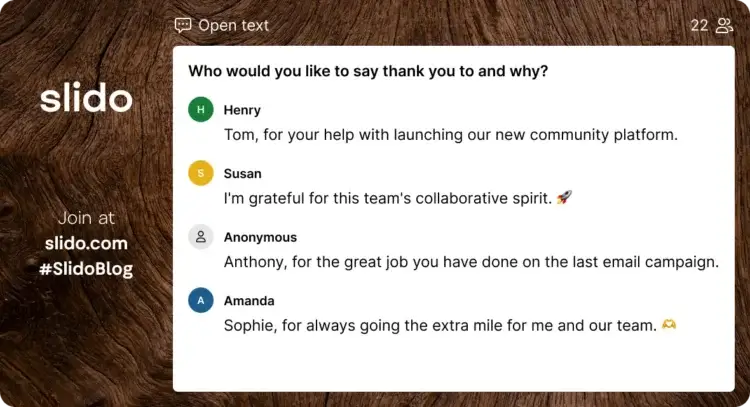
#3 Plan ahead: Ask the team what sparks their interest
You and your team can think things over stress-free, regardless of your personality type.
Send out your meeting agenda a few days in advance, giving everyone a chance to engage at their own pace. This small step can make a huge difference. Team members, whether they’re naturally outspoken or prefer more time to reflect, can digest the topics, form thoughtful responses and even submit questions without the pressure of being on the spot.
When the meeting begins, you’re no longer starting from scratch. Everyone arrives prepared, aligned and ready to jump into a well-considered conversation. This approach not only elevates the quality of discussion but also boosts participation, as even the more reserved voices have had time to consider their thoughts and weigh into the conversation.
You’re set to deliver a smoother, more impactful meeting where all perspectives are welcomed, making it easier to reach productive outcomes without the usual back-and-forth.
💡Useful tip: During the meeting, embrace silence. Silence can feel uncomfortable, but it’s a powerful tool. As a facilitator, embracing quiet moments gives people the space to process their thoughts and contribute more meaningfully. Create intentional pauses for quiet thinking and discussion, allowing different personalities to engage in a way that works for them. This simple shift leads to richer conversations and more thoughtful insights.
#4 Structure your meetings with introverts in mind
Cut through the noise. Slido offers analytical insights, allowing you to measure team engagement, Q&A sentiment and monitor poll results.
If you notice differences between the topics discussed during the call and those raised in Slido, it’s likely you tapped into the interests of your quieter colleagues.
Often, introverted team members may hesitate to vocalize their ideas in real-time discussions. However, providing alternative avenues for input, such as written and potentially anonymous Q&A sessions, can create a space where they feel more comfortable. Suddenly, introverts’ thoughts and ideas will show up.
Next time, you can adjust the meeting structure to cover what also interests your introverted team members. How?
With Slido’s analytics, you’re not just tracking engagement metrics; you’re discovering patterns in team dynamics. When you see discrepancies between the topics from the meeting and those within your Q&A submissions, it’s often a sign that you’ve unearthed interests from voices less likely to speak up in traditional settings.
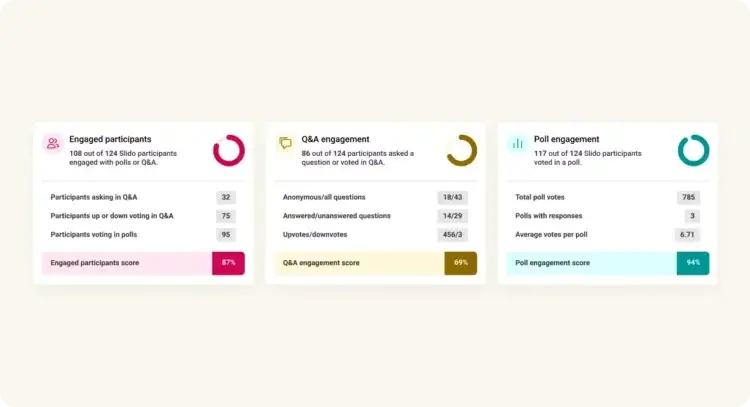
Use these insights to refine your meeting structure. If you notice certain topics generate higher engagement in polls or Q&As, carve out time in your agenda to address them. You can even create a recurring segment tailored to these emerging interests, making the discussion more inclusive and aligned with the entire team’s curiosity.
By subtly shifting focus based on these analytics, you’re crafting a space where everyone feels heard, and meetings become a platform for genuine connection, not just routine check-ins. Slido makes it easy to close that feedback loop, giving you real-time, actionable insights to build a more cohesive and engaged team culture.
Looking onwards
Synchronizing your team and hosting introvert-friendly meetings to fulfill their potential is a challenge worth taking. Why not make it easier with Slido?




